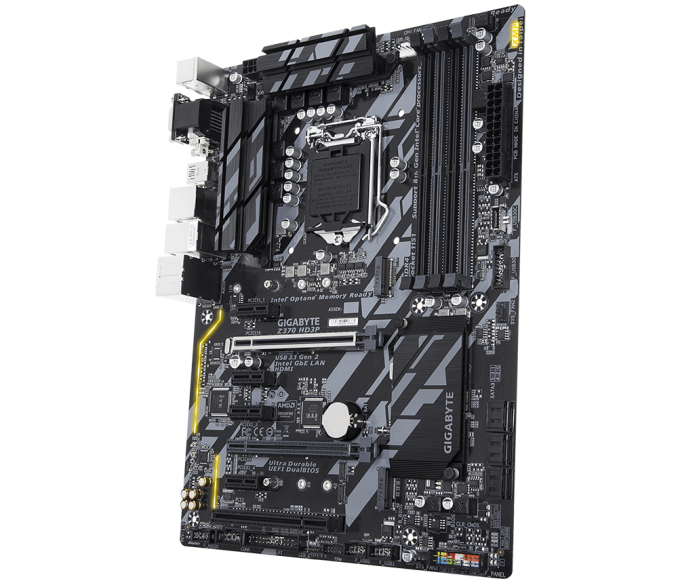Analyzing Z370 for Intel's 8th Generation Coffee Lake: A Quick Look at 50+ Motherboards
by Ian Cutress, Anton Shilov, Joe Shields & Gavin Bonshor on October 20, 2017 2:00 PM ESTGIGABYTE Z370 HD3P
Continuing in the Ultra Durable line, we slide further down the stack and run into the Z370 HD3P. The HD3P looks to do away with a lot of bells and whistles, but still comes well appointed. The HD3P includes USB 3.1 (10 Gbps) ports, Intel GbE LAN with ESD protection, dual M.2 slots, RGB Fusion for RGB LED support (up to 7 colors), and uses the Realtek ALC1220 codec.
Aesthetically, the Ultra Durable line looks different than the Gaming series of boards. The HD3P has the same artistic pattern on the PCB as the XP SLI, but with a more subdued gray stenciling, and only one reinforced PCIe slot for graphics. Keeping with the black and gray theme, two of the DIMM slots are black, while the other two are gray. There are no shrouds to speak of on the board either, leaving the silver color of the ports exposed. The only non-standard LEDs on the board are found on the audio separation line and the XMP display in the upper right-hand corner. There is one RGB LED header at the bottom of the board if the user needs to add more color and light things up inside the case.
We see the familiar four memory slots supporting 64GB of RAM, with speeds up to DDR4-4000 officially supported. The PCIe layout is different to the previous GIGABYTE boards: the first slot is steel reinforced and is the primary x16 slot powered by the processor; the second gray slot is a PCIe x4 from the chipset; the final large connector on the board is a PCI slot, not PCIe. Additionally, there are four PCIe x1 slots which are also fed from the chipset. The board only supports AMD Crossfire configurations due to the x4 lane not meeting NVIDIA criteria for SLI (x8 minimum). The gray PCIe x4 slot is disabled when an SSD is installed in the second M.2 slot as it shares bandwidth.
For storage, we can see the HD3P has two M.2 slots and a total of six SATA ports supporting RAID 0, 1, 5, and 10. There are a total of four hybrid fan headers found on the board with one positioned to the right of top VRM heatsink and another next to the EPS 12V connector. The third is on the right side of the board above the SATA ports, while the last one is at the bottom of the board next to the front panel headers. All can be controlled via the Smart Fan 5 application. The audio side is handled by the Realtek ALC1220 codec using Nichicon audio caps (no WIMA) and does not have EMI shielding. A single Intel GbE NIC is used for network connectivity and has ESD and Surge protection.
USB 3.1 (10 Gbps) functionality is handled by an ASMedia 3142 controller with a Type-C and Type-A port on the back panel IO. Another USB Type-C (5 Gbps) port is available through the internal USB header. USB3.1 (5 Gbps) is supported through the chipset and gives users a total of six ports; four are found on the back panel, and two ports via the internal USB header. USB 2.0 support also goes through the chipset and has two ports on the back panel and another four through internal headers. For the rest of the back panel IO, the HD3P has a combination PS/2 port, audio jacks, DVI-D, HDMI, and a D-Sub output.
The HD3P has fewer bells and whistles than the higher end boards as expected, but makes up for it a bit with the integration of legacy items like a PCI slot as well as a D-Sub for video. Still, there are plenty of modern platform amenities featured for a lower-end budget board.













83 Comments
View All Comments
Mick07 - Wednesday, April 22, 2020 - link
Hi guys, I am a novice & need some help.Are the following cards compatible with this board carrying a Intel Core i7-8700K?
Strix Radeon RX570;
Radeon RX 5700 XT;
RTX 2080 Super.